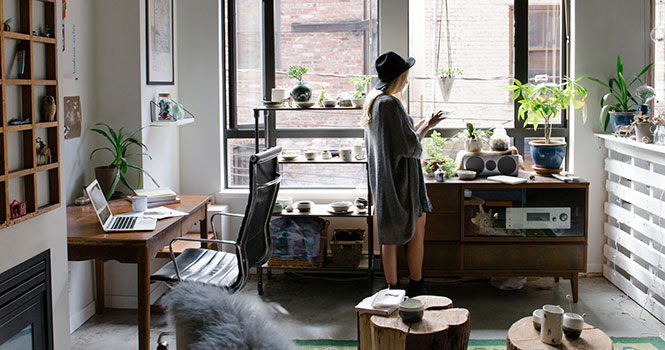While women in business schools and C-level suites may still hover on the low end when compared to their male counterparts, single women are currently proving to be one of the most important demographics in the home-buying market.
The National Association of REALTORS® (NAR) reported this year that — of the recent buyers who are single — single women accounted for 60 percent more home purchases than single men, across all age groups. They are actually the biggest home buying demographic after married couples.
This trend of single female home ownership is projected to increase in the coming years, thanks to a variety of factors. The gender-pay gap is decreasing, giving women increased financial independence. In some areas, their incomes are even increasing faster than their male counterparts’ are.
Generational Gap: Baby Boomers (Still) Own the Housing Market
Even though millennials show great promise in the real estate market, baby boomers are still the largest group of homebuyers. NAR found that single female baby boomers buy twice as many homes as single men do and account for one out of every five houses sold in their own age cohort.
Additionally, baby boomers are wealthier than any other generation. They are set to inherit $13 trillion of wealth in the next 20 years, and 70 percent of them believe that their current home will not be the best one that they live in. Contrary to cat lady stereotypes, a 2015 survey of over 1,000 single boomer females found that the overwhelming majority — 74 percent — are as confident and happy as they were at 35. These women are going to keep buying houses. Better, bigger houses, at that.
This trend affects the housing market as well as the interior design business. A company that targets single female baby boomers would be wise to consider their preferences. Boomers overwhelmingly live in the suburbs and have more space than other generations who camp out in smaller city apartments. Custom hardwood cabinetry, granite or marble countertops, and the ability to customize are all attractive options for single female baby boomers. This slice of consumer will not shy away from affordable luxury, like a glass-gated walk-in shower or custom bathtub.
Per Richard Endres, the owner of E.B. Endres, a residential home remodeling company, “Statistics show the number of single women homeowners is on the rise. We have a number of single women homeowner clients so we are experiencing the statistic first-hand within our residential remodeling division. There are subtle and pronounced differences in how women approach a remodeling project as opposed to men.”
According to Endres, when his company meets with a female client to start a remodeling project:
- She knows her budget and she’s determined to stay within that budget.
- She wants to reflect her personality and her own personal style through the project. Fortunately there are many design styles and options today to choose from.
- She takes time to do her research and make final decisions.
- She wants the best quality products and workmanship she can afford within her budget.
- She is concerned for others. She focuses on comfort for herself as well as family and friends who will benefit from the remodeling project.
It’s clear from this industry insight that single women, regardless of age, are coming into their own in the housing market.
Millennial Focus: Young Adults Will Enter the Market
Millennials tend to live in smaller spaces located within major cities, close to their workplaces and social centers. Also, millennial women tend to get married later (if they plan to marry at all) and are well-educated. Their demand for housing will likely increase along with their salaries. It’s no secret that the U.S. marriage rate has hit record lows in recent years, which makes singles an even more important player in markets like housing, traditionally dominated by married couples.
Millennials also want to differentiate themselves from their parents — McMansion-style designs will not sell well within this age group. They tend to favor unique, stylish, but practical designs. This could mean an in-kitchen cocktail/bar space for entertaining complete with mason-jar cocktail mugs, or a shower with a top-mounted rainfall showerhead that adds a bit of comfort and class to a small space.
Location will be particularly important for this cohort. On the upper end of this market, a preference for apartments or condos in dense communities with vibrant street life is expected. Dense cities like San Francisco or Pittsburgh are currently enjoying downtown booms, with ever-increasing numbers of high-earning women moving in every year.
Future Plans: Housing Options Marketed Across Age Groups
As the housing market continues to change, it’ll be more important to market towards women across all age groups, not just millennials. No generation is homogeneous, and marketing that way is a recipe for failure. A variety of choices and designs targeted towards all women, and features like easy parking, safety and overall affordability, will have obvious appeal for all single females.
Single women are getting a lot of attention in the real estate industry — and for good reason. This group is clearly on the upswing both financially and demographically. The current U.S. economy favors the growth of home buying, despite rising prices in certain areas. Lenders are making it easier and easier to get a mortgage after tightening the screws during the financial crisis. Many are saying that the time to buy a home is now, since property prices in the U.S. overall are expected to increase in value following the housing bust.
All in all, in an increasingly fragmented market, single women are the most important demographic to watch out for. They are increasing in power, wealth and market share, and are a force to be reckoned with.
This post was originally published on RISMedia’s blog, Housecall. Check the blog daily for top real estate tips and trends.











